Key takeaways:
- Negative feedback serves as a crucial learning tool, encouraging photographers to grow and refine their craft by seeing their work from new perspectives.
- Constructive criticism fosters community among photographers, promoting collaboration and shared growth through diverse opinions and experiences.
- Analyzing feedback helps uncover blind spots in technical skills and emotional storytelling, leading to enhanced artistic expression and improved techniques.
- Maintaining a ‘feedback journal’ allows artists to document critiques and track growth, turning negative feedback into actionable insights for future projects.
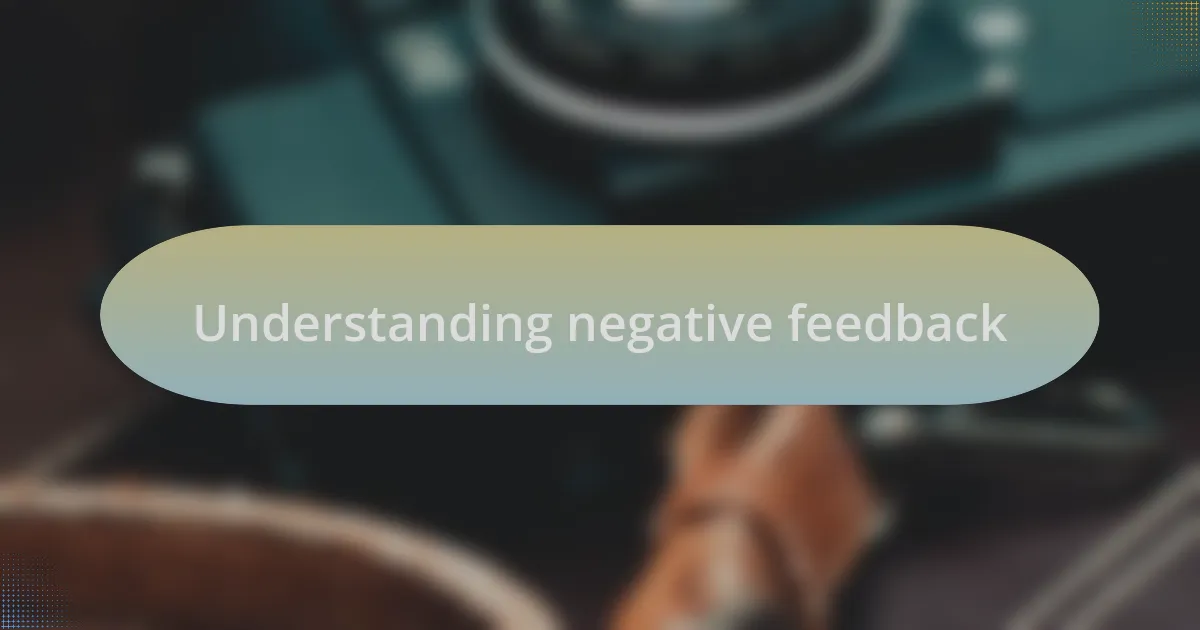
Understanding negative feedback
Negative feedback can feel like a punch to the gut, can’t it? I remember when a fellow photographer critiqued my work at a forum, pointing out flaws I hadn’t noticed. Initially, I wanted to defend myself, but it dawned on me that this feedback offered a fresh perspective that could enhance my skills.
When receiving criticism, I often find myself asking, “What can I learn from this?” It’s a question that transforms the sting of negativity into a springboard for growth. Embracing feedback as a learning opportunity takes practice, but I’ve seen firsthand how this shift in mindset can reshape my creative process.
I’ve also learned that negative feedback isn’t always a reflection of who we are as artists. Instead, it can serve as a mirror, revealing areas for improvement. Once, after sharing a portrait I thought was superb, the critiques opened my eyes to aspects I hadn’t considered, like lighting and composition. It made me realize that every piece of feedback contributes to my evolution as a photographer.
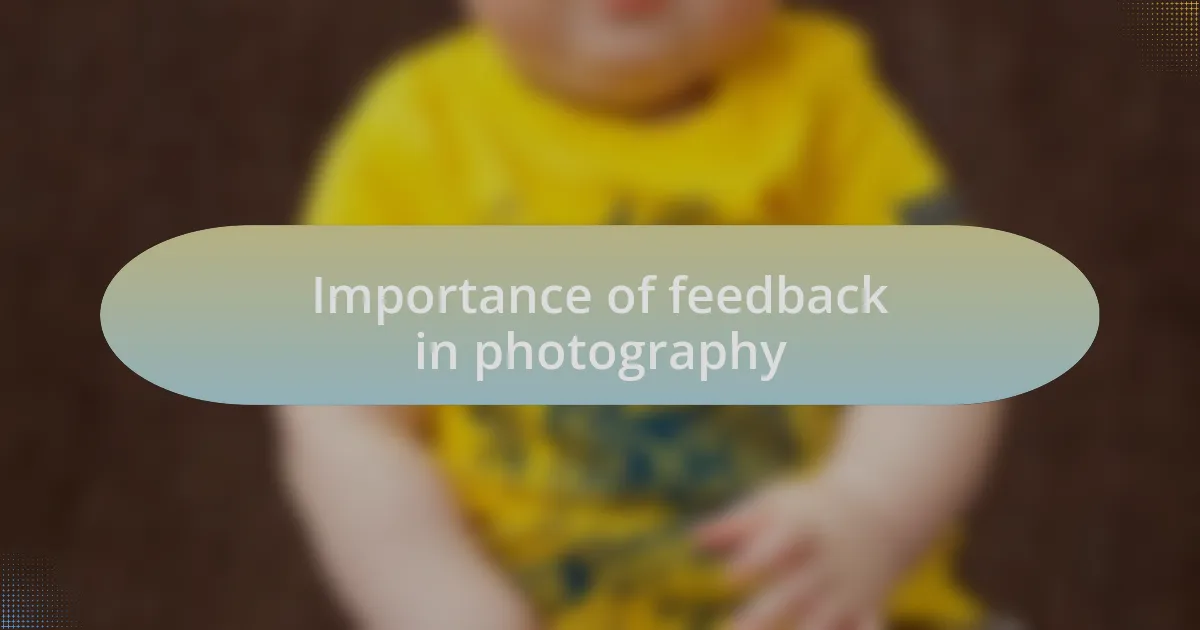
Importance of feedback in photography
When it comes to photography, feedback plays a crucial role in refining our craft. I can recall a time when a harsh critique of my landscape photography made me rethink my approach. It was tough to hear, yet that very feedback pushed me to experiment with different angles and lighting techniques. Isn’t it fascinating how constructive criticism can lead us into uncharted territories of creativity?
Receiving feedback allows us to step outside our own perception, which can sometimes be surprisingly limited. I had a mentor who emphasized the importance of viewing my work through others’ eyes. One day, after sharing a photo I was proud of, the varying opinions revealed blind spots I hadn’t noticed before – like the need for more dynamic compositions. Have you ever experienced that moment when you realize your audience sees something entirely different from what you intended? Such realizations can be utterly enlightening.
Moreover, constructive criticism can foster a sense of community among photographers. I once participated in a group critique session, and while the feedback varied, the camaraderie was palpable. Everyone was striving to get better together, sharing tips based on their experiences. This spirit of collaboration not only helps elevate our skills but also nurtures a supportive environment where everyone can thrive. Isn’t it enriching to know that you’re part of a community that values growth through honest feedback?
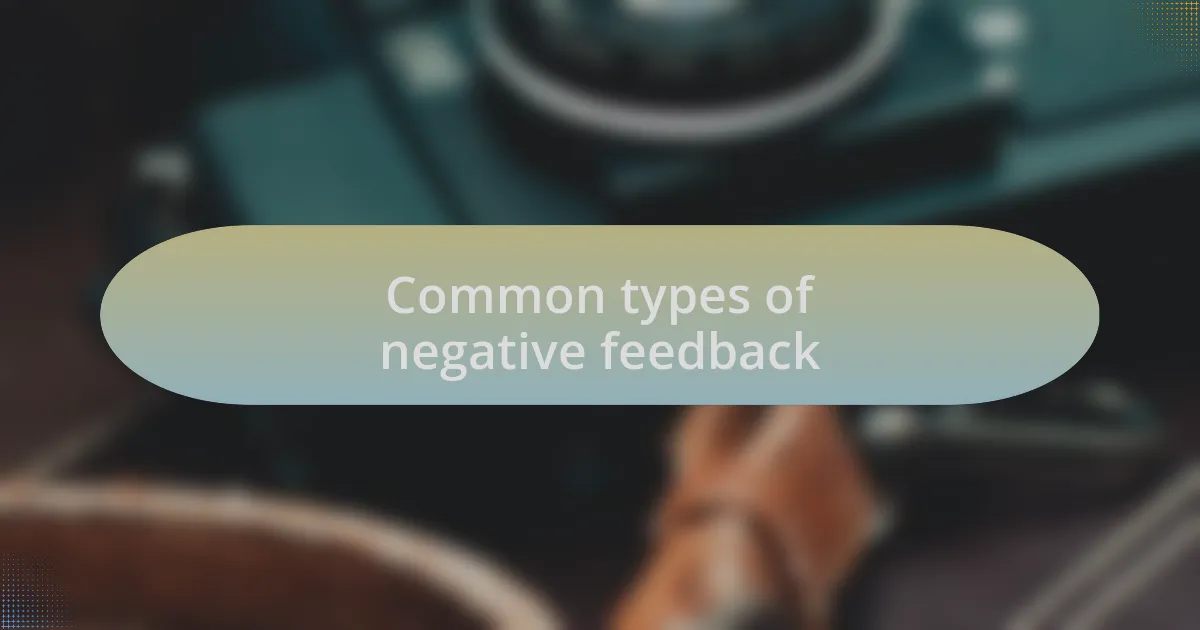
Common types of negative feedback
When thinking about negative feedback, one of the most common types I encounter is comments focused on technical flaws, like exposure issues or focus problems. Just the other day, I shared a portrait I had worked hard on, only to be met with critiques about overexposure. At that moment, I felt a mixture of disappointment and determination. It was tough to hear, but it pushed me to delve deeper into understanding lighting and how it affects my subjects.
Another frequent form of negative feedback is subjective opinions about composition or style. I remember sharing a street photo that resonated with me, but feedback pointed out that the framing seemed chaotic or distracting. Initially, I felt frustrated—after all, art is subjective, isn’t it? However, this type of criticism offered a new perspective on how others perceive my work. It encouraged me to rethink my compositional choices and consider how the viewer’s experience matters just as much as my intent.
Lastly, feedback on emotional impact can be particularly gut-wrenching. I once posted an image intended to evoke nostalgia, but some viewers found it lackluster. Hearing that was like a punch to the gut—I thought I had captured something special. Yet, that prompted me to reflect on how emotions translate through visuals. I started experimenting with different storytelling techniques, realizing that each critique helps shape my artistic voice. Have you ever had a similar experience where feedback led to a deeper understanding of your own artistic expression?
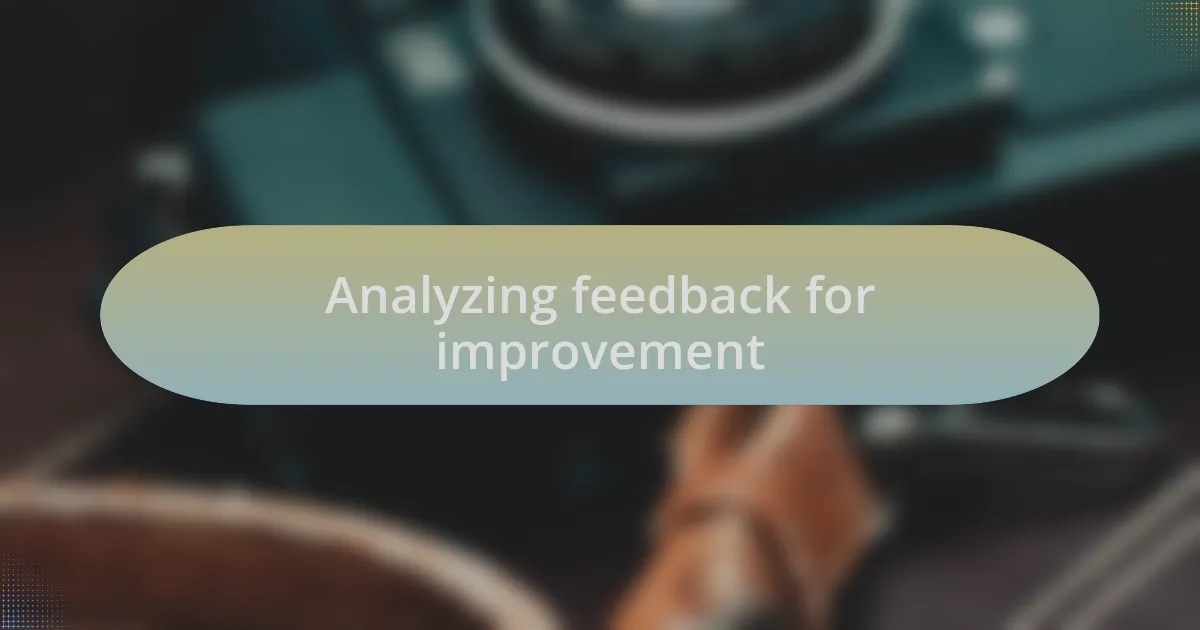
Analyzing feedback for improvement
Analyzing feedback is a critical part of growth. For instance, when I received comments about my use of color in a recent landscape shot, it struck me deeply. I felt a blend of confusion and curiosity—why did my choices not resonate? This motivated me to dissect the feedback further, looking into color theory and how emotions can be conveyed through hues. In doing so, I began to understand that what may feel vibrant to me might not invoke the same feelings in others.
Every critique is an opportunity to refine your craft. I once shared a macro shot that, frankly, I thought was my best work, only to encounter remarks questioning its focus. After swallowing my pride, I took time to analyze the comments. It prompted me to revisit my shooting techniques and experiment with different settings on my camera. Addressing these technical criticisms not only improved my skills but also revealed a crucial insight: every detail matters in photography, and learning from others is invaluable. Have you ever had a moment where you realized that feedback was just what you needed to elevate your work?
There’s an emotional layer to analyzing feedback that often gets overlooked. I recall a time when a fellow photographer pointed out the lack of storytelling in one of my images. Initially, I felt defensive—after all, I believed my intent was clear. But as I replayed that feedback in my mind, I found myself reflecting on what makes a photo memorable. It dawned on me that my vision might not have translated effectively to others, and that realization led me to focus more on narrative elements in my future projects. How has feedback pushed you to redefine your artistic boundaries?
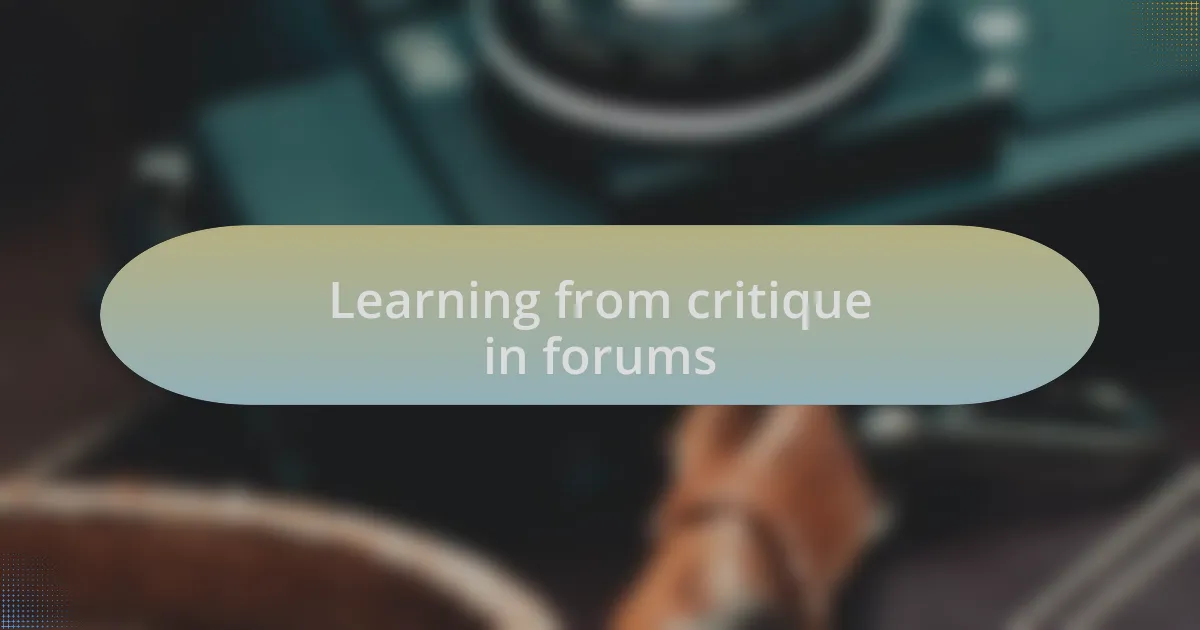
Learning from critique in forums
Engaging with critiques in photography forums offers valuable perspectives that can challenge our artistic intuition. I remember sharing a portrait I was proud of, only to have several forum members comment on the harsh lighting. At first, I felt blindsided; after all, I loved the dramatic effect. However, this feedback prompted me to consider how lighting influences mood. I experimented with softer light in subsequent shoots, ultimately discovering a new depth in my portraits that I hadn’t even realized was missing.
Forums can also be a wonderful space for constructive dialogue. Once, I received a critique about the composition of a landscape shot that I thought captured a breathtaking sunset. Readers suggested cropping to create a stronger focal point. Initially, I hesitated to crop what I believed was a perfect frame. Yet, I took the plunge, and to my surprise, the adjusted version felt more engaging. This taught me that collaboration and diverse opinions can transform how I see my work and not to shy away from constructive suggestions.
Moreover, it’s important to remember that not all critiques will resonate. I once encountered harsh criticism on an experimental piece I shared—comments ranged from dismissive to excessively critical. Initially, it stung, and I questioned my abilities. However, reflecting on the feedback helped me realize that while some perspectives weren’t useful, others encouraged me to explore different techniques. How do you differentiate between constructive criticism and noise? For me, it’s about aligning feedback with my artistic vision while remaining open to growth.

Personal experiences with negative feedback
Reflecting on my journey, I recall sharing a street photography series that I believed captured the essence of urban life. To my surprise, some members pointed out issues with focus and composition. Their blunt assessments initially felt like a punch to the gut, making me wonder if I truly understood my chosen art form. However, this moment pushed me to reassess my techniques and eventually led to a marked improvement in my work.
In another instance, I submitted a black-and-white photo that I felt encapsulated raw emotion. The feedback ranged from “flat” to “uninspired,” which, admittedly, left me deflated. As I took a step back and reflected on their comments, I realized that these critiques were calling for a more dynamic use of light and shadow. This realization was a game-changer; I began to experiment more boldly with contrast, ultimately breathing new life into that very subject I once thought I’d nailed.
Finally, I can’t forget the time I posted an experimental abstract piece. While most responses were politely vague, one particular critique hit home: “It seems lost.” At first, I felt a wave of defensiveness, but then I sat with that feedback. It challenged me to clarify my intentions behind the shot. Why was I creating abstract work? The process forced me to delve deeper into my motivations, leading to a richer exploration of what abstraction truly means for me. How often do we let the fear of negativity prevent us from uncovering deeper truths? Personally, confronting discomfort has always opened doors I never knew existed.

Applying lessons to future work
When I reflect on the critiques I’ve received, I realize they’ve served as a roadmap for my improvement. For example, after receiving feedback on my landscape photos, stating that they lacked depth, I decided to revisit my approach to foreground elements. Now, I consciously think about how every component in the frame interacts, enriching the viewer’s experience. Isn’t it fascinating how a simple perspective shift can transform a photograph?
In another project, I submitted a portrait series that I thought conveyed vulnerability. The feedback, highlighting that my subjects seemed stiff and unnatural, was tough to take. It led me to realize how crucial it is to build rapport with my models. I began to focus on the story behind each shot, striving to create a comfortable scene where emotions flowed freely. Have you ever noticed how genuine connection can elevate a photograph from ordinary to extraordinary?
As I dive into new projects, I’ve made it a habit to keep a ‘feedback journal.’ Each time I receive constructive criticism, I jot it down alongside my reactions and what I plan to change next time. This practice not only helps me track my growth but also turns negative feedback into a powerful tool for future shoots. If we don’t document our learning, how can we truly appreciate our progress? By embracing these lessons, I feel more equipped and inspired to tackle new creative challenges.